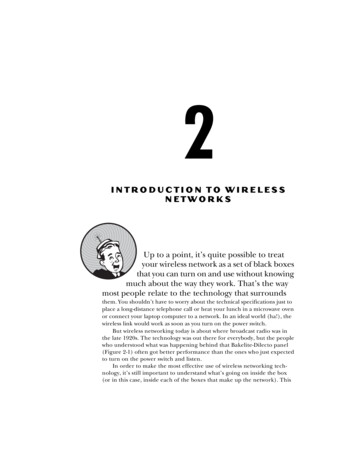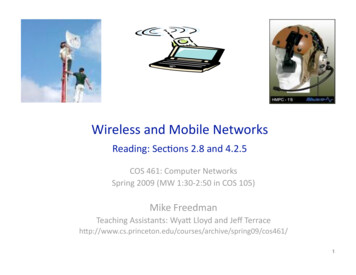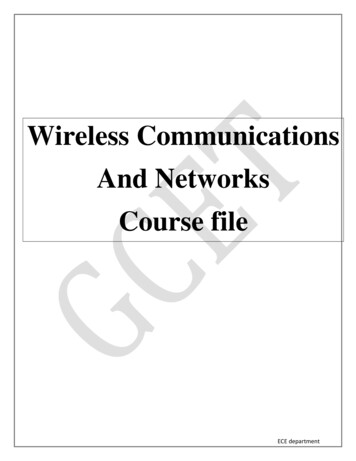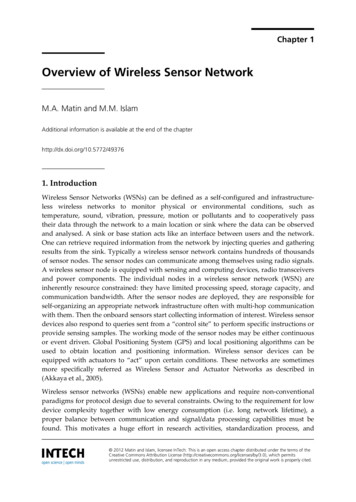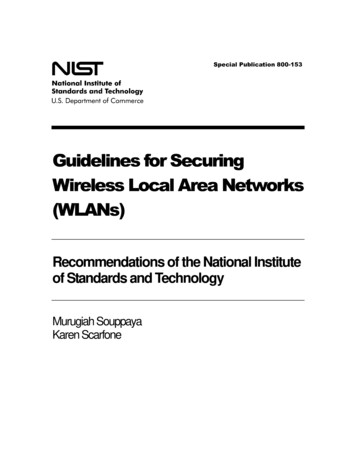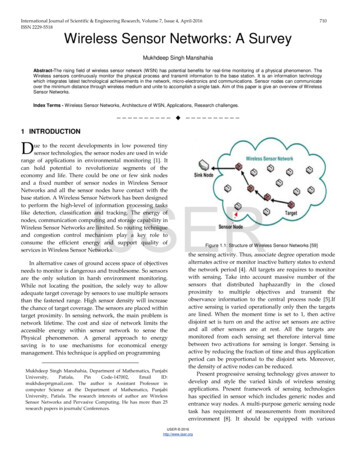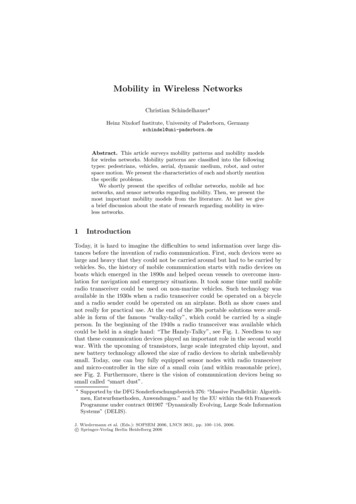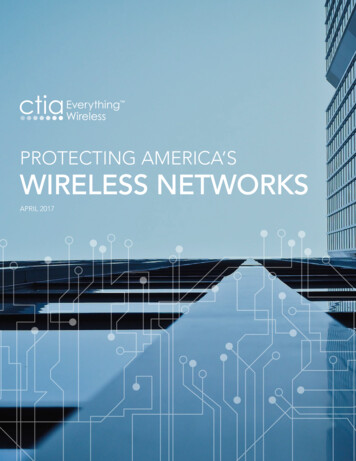
Transcription
PROTECTING AMERICA’SWIRELESS NETWORKSAPRIL 2017
EXECUTIVE SUMMARYThe wireless industry is on the front lines every day, protecting our consumers, our networks, and our technology from badactors and cyber threats. We’re proud of our investment to keep America’s wireless networks safe, as well as our collaborativepartnerships with key government agencies that enable industry and other stakeholders to respond quickly and effectively tothreats. As the threat landscape evolves, we must continue to invest and refrain from static regulatory mandates.Cyber threats and the organizations behind them are highly resourced and sophisticated. That’s why America’s wirelessindustry works 24/7 to protect our consumers and our networks, investing significant time and money and using every tool wehave at our disposal. With each generation of wireless, our networks become more secure and the technologies and tools weuse to protect you become more advanced.Now, our world is more connected than ever. With 5G and the Internet of Things (IoT) coming, we’re baking security into ournetworks because consumers—and our country’s economy—depend on us.Cybersecurity is a top industry priority and policymakers can help with flexible, technology-neutral approaches that let usinnovate quickly to protect American consumers and businesses. This will not be possible unless all stakeholders, includingconsumers, do their part.IN TODAY’S CONNECTED WORLD,SECURITY IS CRITICAL TOEVERYONE AND EVERYTHINGAcross the United States, nearly 380 million wirelessconnections join people and increasingly every part of ourworld together.1 That’s roughly 1.2 wireless connectionsfor every person in the country. Those connectionsgenerate tremendous traffic over wireless networks: 9.65million terabytes of mobile data in 2015 alone—morethan doubling the prior year’s record levels.2 Indeed, since2010, mobile data traffic has grown roughly 25 times.3We’re only going to grow more connected. Tomorrow’s5G networks will offer unparalleled speeds, support amassive increase of IoT devices, and enable real-timeconnections with minimal delays in response, enablingentirely new services and applications.4The Internet of Things—bringing broadband connectivityto consumer and industrial devices, sensors, and objects—will usher in increased productivity and growth acrossevery economic sector, from transportation and healthcare to public safety and energy. The number of IoTdevices worldwide is projected to total around 18 billionin 2022.5As wireless networks evolve, so do cyber threats. Thewireless industry is always enhancing network functionsand introducing new devices and applications. Asnetworks change, cyber threats grow in number andsophistication, with new risks and exploits to address.These threats are serious, often launched by highlyresourced intelligence services abroad, organized criminalnetworks, and motivated entities seeking to disruptcommunications networks, here and around the world.TODAY’S THREATSProtecting our networks is a year-round 24/7 effort as cyberthreats today come in many forms, from malware and attackstargeting IoT devices to cloud infrastructure exploits andmobile threats.MalwareMalware includes Trojan packages used totarget financial information and ransomware6that locks a user out of their system until theypay for re-access.Mobile ThreatsThese threats include attacks on mobileapplications, phishing attacks to install malicioussoftware, and attacks to trick users to divulgeaccess credentials such as personal passwordsor PINs.Internet of ThingsAs the IoT expands, new opportunities forpossible exploits by hackers and cybercriminalshave emerged with the development of sensors,cameras, meters, monitors, and other devicesthat can be targeted—and exploited—by hackersand other bad actors absent corenetwork protections.Cloud InfrastructureFor instance, a Distributed-Denial-of-Service(DDOS) attack could use commandeered IoTdevices to overwhelm elements in the cloud torestrict or deny the availability of targeted onlineservices.Network AttacksAttacks could be launched by leveragingexisting network protocols such as SS7 toexecute surveillance and interception attacks.
Strong cybersecurity iskey to delivering wirelessbroadband. We invest sothat America can remainsafe, secure, and a worldleader in wireless and 5G.KEEPING AMERICA’S WIRELESS NETWORKS SAFE AND SECUREThe entire wireless industry works together toprotect our networks and our consumers.Given the seriousness of the cyber threat landscape and howit evolves day-in and day-out, wireless network operators,device manufacturers, and operating systems (OS) andapplication service providers continue their effective,collaborative, and risk-based management approach thatemphasizes security as an integral component. As threatsincrease, the wireless industry invests more in cybersecuritysolutions—investments that total hundreds of millions ofdollars every year.7Compared to global peers, the security of America’s wirelessnetworks reflects that investment in this top industrypriority. While mobile malware doubled in 2016, mobilethreats amount to about two percent of all malware threats,8and infection rates in North America have remained in thesingle digits while other regions experience infection ratesnearly twice as high.9Wireless NetworksToday, mobile devices use different air interfaces available toconnect to wireless networks—air interfaces include 3G, 4G,Wi-Fi, or Bluetooth. But not all air interfaces offer the samecybersecurity defenses. Some networks, like open Wi-Fihotspots, present security challenges and risks, including thecollection and transmission of device information, access tocompromised websites, and phishing attacks that provideunauthorized device access.10That’s why America’s wireless carriers equip theirnetworks—3G, 4G, and soon 5G—with a variety of defenses5that protect consumers, including:Using standards-based encryption algorithms onair-interfaces to prevent unauthorized access toinformation over the air.Deploying authentication standards that operate asa guard, validating and authorizing the user seekingto access the network in order to ensure that onlylegitimate people are accessing the network. Thesestandards use enhanced cryptographic keys tosafeguard network access.Ciphering or coding data sent over the network toensure it is kept free from corruption and/ormodification.Increasing the availability and reliability of wirelessnetworks by building in multiple redundancies,deploying back-up power solutions, and other networkmanagement techniques.Deploying a robust set of anti-spamming software onour networks to protect consumers from unsolicitedSMS/MMS messages.Instituting strict access controls to limit and monitornetwork resources—physical and IT access—to protectagainst internal and external bad actors.Mobile DevicesToday, smartphones and tablets are ubiquitous, makingthese mobile devices targets for cyberattacks. That’s whymobile device manufacturers build in a number of securitymechanisms that protect devices from cyber threats,including:SIM CardsAn integrated circuit for storing and authenticatingcritical subscriber identity information, a SIM (SubscriberIdentification Module) card enables a secure and reliablevoice and data connection and the ability to provision newapplications and services remotely.113
4G LTE NETWORK ARCHITECTUREMobile (UE)Radio Access Network (RAN)Temporary IdentitiesTo mitigate the risk of serial numbers being compromised,networks use temporary identities that vary regularly, helpingprevent interception by unauthorized users.Anti-Theft ToolsThe mobile industry’s voluntary anti-theft commitmentprovides consumers the tools to locate, lock, and wipe theirdevice in the event of theft or loss.12Roots-of-TrustBuilt into mobile devices, this hardware-basedcryptographic information is used to detect malware andauthenticate system software integrity.Mobile OS/AppsMobile OS providers like Android, Apple, and Microsoft workwith app developers to improve security while screening forbad applications at app stores in order to prevent the spreadof viruses and malware. That’s why mobile OS providers andapp developers have created software that protects wirelessdevices and consumers, including:Anti-Malware and Anti-Virus SoftwareThis software, which varies by operating system, prevents,detects, and removes malware.Device SecurityIf a device is stolen or lost, personal and sensitiveinformation contained in the device can be madeinaccessible to an unauthorized user. Tools are providedto consumers for such protection.The wireless industry uses every tool to defendagainst cyber threats.From authentication and encryption to licensed spectrumand solutions like firewalls and security gateways, wirelesscarriers use an all of the above strategy to protect ournetworks.SpectrumExclusive, licensed use spectrum provides wireless networkproviders the ability to ensure interference protection andenable Quality of Service (QoS). Purchased by an operatorCoreInternetat an auction or on the secondary market, licensed spectrumenables “carrier grade” quality for wireless voice, messaging,data, and video services.13Licensed spectrum will also be critical to future 5G servicesincluding wireless medical consults, virtual reality sessions,and vehicular safety applications that will require QoS andlow latency to ensure real-time performance.14 The industrialIoT will also require a heightened end-to-end solution,particularly for critical infrastructure services and industries,and LTE—riding on licensed spectrum—provides theunderlying platform for the necessary end-to-end security.In addition, wireless industry certification regimes15 are criticalfor validating key security functions, like over-the-air softwareupdates and patches, which help secure managed-IoT environments and set the foundation for 5G and next generationwireless services. The wireless industry is evaluating optionsfor certifying that key security capabilities are implemented indevices being attached to networks, to help mitigate risks todevices, networks, and end-user applications.StandardsWireless network security standards processes arecomprehensive and have proven effective. Driven by industryparticipation, standards-setting and standards-developingorganizations are developing global standards that willprovide dynamic, resilient, and safe wireless networks tocounter security threats for a connected world.Key standards-setting organizations include the following:3GPP is developing security and privacy standards for wirelesstechnologies, architectures and protocols.16 3GPP is alsodeveloping several cryptographic algorithms, which are apart of the end-to-end security solution and will provide forongoing enhancements to mobile cybersecurity.IETF is developing security requirements for networkprotocols for end-to-end device security and the IoT.17These efforts build on several successful security protocolsand standards IETF has developed, such as IP Security,Transport Layer Security, and Simple Authentication andSecurity Layer.
ETSI is responsible for the standardization of cybersecuritystandards internationally and for providing a center ofrelevant expertise for information and communicationstechnologies, including mobile.In addition, the National Institute of Standards andTechnology (NIST) convenes the private sector to developan industry-driven methodology—the CybersecurityFramework—to assess and manage cybersecurity risksand outcomes. This framework is intended to help privatesector organizations that provide critical infrastructure withguidance on how to protect it, along with relevantprotections for privacy and civil liberties.Network security and monitoring tools are key.Wireless Radio Access NetworkThe radio access network (RAN) provides the radiocommunications between the mobile and the core network.Base stations provide the air-interface radio connection between the mobile device and core network, perform mobilityand handover, and ensure good performance and allocationof shared radio resources.helping ensure radio access and prevent denial of serviceattacks.Access ControlsThese tools enable the detection of unauthorized access toRAN resources and the ability to deny access if appropriate.Wireless carriers use an all of the above strategy to protectour networks.Wireless Core NetworkThe core network consists of data gateways or routers,mobility management platforms, policy and billing, and thehome subscriber database.The data gateways and major routing platforms carry IPtraffic from many connected devices through the corenetwork and out to cloud services or the Internet.The risk is that many devices can simultaneously attempt toconnect, effectively creating a denial of service attack, orattackers could steal a master key that would give access tothe entire network.19 That’s why wireless operators deploy anumber of tools used to monitor, guard, and protect the coreplatforms and subscriber database, including:To prevent intruders from accessing air interfacecommunication information, or eavesdropping in otherwords, wireless network operators equip their RAN withfunctions that ensure the security of the radiocommunications functions and interconnection to the corenetwork. Specifically, RAN security features include:Mutual Authentication FunctionsTo detect and prevent “spoofing,” these functions usean Authentication and Key Agreement protocol betweenthe mobile device and the RAN that allow the device toauthenticate the network, and the network to authenticatethe device.18IPSec EncryptionUsing a protocol called IPSec, the RAN can encryptcommunications in the back-haul connections to the corenetwork and also detect and mitigate unauthorized access,Firewalls that block certain types of network traffic,forming a barrier between a trusted and untrustednetwork—analogous to a physical wall that blocks andisolates the spread of an attack.Intrusion prevention systems and intrusiondetection and prevention systems that monitornetwork activities for malicious activity—helpingidentify malicious activity, record information aboutthe activity, and block or stop it.Malware monitoring and detection to target hostile orintrusive software, including computer viruses, worms,Trojan horses, ransomware, spyware, adware,scareware, and other malicious programs.WIRELESS CORE NETWORK SECURITYMobility ManagerServing GatewayAuthenticationCenterPacket GatewayCore5
Virtual Private Networks that enable traffic to be sentthrough a secure connection, isolating that traffic fromother devices on intermediate networks. Capableof connecting individual users to a remote network,application or multiple networks, VPNs requireauthentication for remote and use encryptiontechniques.These functions within the core network are highly securein terms of physical security and access controls, requiringgated facilities, guards, secure card entry, sophisticatedlogin/password controls, and other measures. Not onlyare security functions a high priority, the core network ismanaged by trained and specialized personnel who aresecurity and risk management experts.Cloud-Based SecurityWhether running apps, storing data, or delivering services,the cloud—a network of servers—have proven popular andefficient for delivering carrier grade text messaging, socialnetworking, banking, e-commerce, and mobile health. Theseservers and the mobile applications and services they enablehave become a target for new threats, and this mattersbecause the all-IP architecture and openness of the Internetprovides broad and diverse entry points to the mobilenetwork for possible attacks.That’s why wireless network providers work to ensure thesecurity of their network vis-à-vis cloud-based services andapplications, including:Secure interconnection and transport from the corenetwork out to the cloud and Internet.Mutual authentication techniques, limitingand monitoring the number of entry points into themobile network, and using highly securecommunication links as appropriate.Collaborating with the entire network ecosystembecause if a customer goes to a risky website anddownloads files with malware, the other parts ofecosystem must help detect and clean the infectedfiles.Security has become stronger as wirelessnetworks evolved.As wireless carriers keep innovating, so do our securitymeasures. From the 2G networks of twenty-five years agoto today’s 4G networks, the wireless industry has increaseddigital coding, encrypted the air link, strengthened mutualauthentication, and added cryptographic techniques.With standards work ongoing for decades, each newgeneration of technology brings security improvementsincorporated across a broad set of global standards:2G/3GBoth 2G and 3G provide for network-based authenticationof mobile devices as well as data encryption capabilities.Improvements added in these generations of mobile serviceincluded authentication and encryption that deterred eavesdropping and fraudulent service theft.
WIRELESS EVOLUTION4G4G provides a strong security platform, involving an endto-end security architecture that leverages the advancesof earlier mobile generations from the device throughthe network and into the cloud. 4G incorporates strongcryptographic and authentication techniques such asmutual authentication between various elements of thearchitecture to ensure a secure environment.5GAs we move towards 5G, wireless network providersare working with industry standards bodies to build onexisting security features and include new innovationsinto the network design and development process fromthe beginning. 5G networks will be designed to buildon the security approaches already in widespread useacross today’s 4G mobile ecosystem and will adapt to thechanging threat landscape.Global mobile industry standards bodies have identifiednew opportunities to enhance our security protocols. Withthe wireless industry working cooperatively for advancesin encryption and security protocols for threat detectionand mitigation, these groups recommend that 5Gincorporate:Physically independent structural blocks organizedto form an end-to-end all-IP-based system, creatingdistributed network security that supports an openarchitecture and distributed security control.Fragmented or diverse ownership of end-to-endnetwork assets requiring improved mutualauthentication across network elements.Flexible security based on open architecture wherelarger networks often need to be connected tosmaller networks, and smaller networks offer simplerand more efficient ways to implement securityprotocols.Advanced security and encryption technologies builtinto mobile devices, as well as advanced authentication schemes, like biometrics.1GApplicationVoiceConsumer BenefitsNationwide Cellular/Wireless Service2GApplication Text, Email, Limited InternetConsumer Benefits Secure Voice, SMS, Longer Battery Life3GApplication Social Media, Video StreamingConsumer Benefits Secure Internet, Access to Data, MMS,Video Messaging4G LTEApplication HD Video, VR, AR, High-Speed DataConsumer Benefits All IP, Broadband Smart Phones, Low Latency,Backward Compatible
INVESTMENT IN SECURITY— GENERATION BY GENERATION1GThreats: Analog, Fraud, Eaves Dropping2GThreats: Attacks on EncryptionGeneral Improvements: Digital, Air-link Encryption3GThreats: Exploit Clear Transmission of IMSI, Hacking In/Out Going CallsGeneral Improvements: Mutual Authentication Between Mobile and Base Station4G LTEThreats: Includes Internet IP Based Security ThreatsGeneral Improvements: Strong Encryption Techniques With Built In Security MechanismsGETTING CYBERSECURITY RIGHTTO ENSURE AMERICANSARE PROTECTEDAll of us have key roles to play in protecting our onlinesecurity and privacy.Everyone—consumers and businesses, industry andpolicymakers—has a stake in cybersecurity and aresponsibility to help protect against cyber threats.CTIA convenes our industry, helping identify risks andstrategies to address cyber threats. Through ourCybersecurity Working Group, the wireless ecosystem workswith key government agencies from the National SecurityAgency to the Department of Homeland Security.The wireless industry also works together to respond tochallenges. For example, responding to mobile devicetheft in 2013, network operators, device manufacturers, andOS companies made the “Smartphone Anti-Theft VoluntaryCommitment”20 to protect new models of smartphonesagainst unauthorized use if they are lost or stolen.The industry also educates consumers by providing bestpractices to protect their data, ranging from how to configuredevices to be more secure to how to understand the securityon different types of networks.The more consumers understand the risks online and themany layers of protection currently available, the safer theybecome. By following simple security practices, consumerscan help make their wireless experience safe and secure.Using PINs, passwords and other features can help protectyour mobile device and personal information, and apps areavailable that can locate, lock, and/or erase your wirelessdevice if it gets lost or stolen.Policies to help protect Americans and the wirelessnetworks we depend on.Wireless companies must monitor, protect, diagnose, andfight potential cyberattacks in real time, and that’s whypolicymakers should promote flexible, technology-neutralsolutions and focus on cyber threat information sharing withappropriate liability protections.To ensure we can continue to innovate as fast as cyberthreats do, we need voluntary, collaborative, industry-ledefforts—avoiding mandates that quickly become outdated.
CONSUMER USE OF WIRELESS SECURITY FEATURES CONTINUES TO RISE80%Today, nearly 80% of consumers enablesecurity on their smartphones, an increase of54% from five years ago.77% of consumers run software updates for their smartphonesevery time or almost every time.57%57% of those who have enabled remote lock/locate security have done so because theynow have a smartphone with that capability.23%Users with anti-virus or anti-malware softwarehave grown 23% since 2015.59% of smartphone owners now say their device has remote lock/locate capability.Source: Harris Poll.21While many federal agencies have roles to play, theDepartment of Homeland Security is critical in conveningindustry and government stakeholders to work togethertoward a common framework to address cybersecurity.will be critical to meeting the challenge of protecting ournetworks and our consumers against the dynamic globalthreat landscape.The ability to share information about cyber threats andeffective countermeasures among industry players andbetween industry and government is crucial, as is promotingsuch information sharing with effective industry liabilityprotections. After Congress passed the CybersecurityInformation Sharing Act22 in 2015, CTIA has focused onmoving beyond information sharing trials to automatedsharing via new technologies.Specifically, CTIA’s Cyber-threat Information Sharing Pilot isworking to facilitate integration with the DHS AutomatedInformation Sharing (AIS) portal. This effort aims to automatethe sharing of threat information among carriers to rapidlyand effectively mitigate cyber-threats.We urge policymakers to keep up this collaborative approachwith the wireless industry on important and complex 5Gsecurity issues in order to encourage actions that can betaken in standards groups and other organizations. As wemove toward 5G, the next-generation of wireless, flexibility9
ENDNOTES1. CTIA’s Wireless Industry Summary Report, Year-End 2015 Results (2016), at less-industry-survey.2. Id3. See id.4. 5G networks will be 10 times faster than 4G networks, respond 5 times as quickly, and connect 100 times the number ofdevices. Thomas K. Sawanobori, CTIA, The Next Generation of Wireless: 5G Leadership in the U.S., at 5 (Feb. 9, 2016),at library/5g-white-paper.pdf.5. Ericsson Mobility Report 2016, at 33 (Nov. 2016), at er-2016.pdf.6. Ransomware is malware that installs itself on a mobile device without the knowledge of the user and extorts paymentonce device information is locked, usually encrypted, and held hostage in exchange for a ransom payment.7. CTIA, Today’s Mobile Cybersecurity: Blueprint for the Future, at 6 (Feb. 2013), http://files.ctia.org/pdf/Cybersecurity White Paper 2.pdf.8. See McAfee Labs Threats Report, at 36-37 (Apr. 2017), at rterly-threats-mar-2017.pdf.9. Id. at 38.10. Other risks include the International Mobile Equipment Identity (IMEI) and International Mobile Subscriber Identity (IMSI)being intercepted and used to track a mobile device.11. Manufacturers limit access to SIM cards to minimize risks from the challenges of the application ecosystem.12. Smartphone Anti-Theft Voluntary Commitment, CTIA (2016), at es/smartphone-anti-theft-voluntary-commitment; Capabilities that the mobile industry deploys to protect networks andconsumers from threats and bad-actors.13. As we move further into use of all IP architectures with voice being provided over a data channel using Voice-over-LTE(VoLTE), Quality of Service (QoS) attributes are used to prioritize the packets so voice quality is maintained at a high levelover other traffic like e-mail and web browsing. Licensed spectrum enables operators to provide VoLTE for consumers andbusinesses. Video conferencing is another example of a service that depends on licensed spectrum to maintain QoS forboth the video and audio in real-time services.14. Thomas K. Sawanobori, CTIA, The Next Generation of Wireless: 5G Leadership in the U.S., at 11-12 (Feb. 9, 2016), document-library/5g white-paper web2.pdf. See also Mary-Ann Russon, Whatwill 5G be used for? Self-driving cars, connected home appliances and incredibly smart cities, Int’l Bus. Times (Nov. 7, 2015), y-smart-cities-1527420.15. See e.g., Certification, CTIA (2016), at http://www.ctia.org/initiatives/certification.16. S A3 – Security, 3GPP, ry/sa3-security#term0 1 (last visited Apr. 10, 2017).17. See e.g., Best Current Practices for Securing Internet of Things (IoT) Devices, IETF (Oct. 21, 2016),at ecurity-bcp.18. Such authentication functions include SNOW 3G (designed by Lund University, Sweden), and the Clock cipher standard(NIST, USA), or Stream cipher.
19. This is a more serious but significantly less likely scenario: Attackers may be able to steal K (128-bit master key) from theCarriers’ Home Subscriber Server (HSS) or obtain it from UICC manufacturer. Safeguarding security keys is one of the mostguarded measures established by SIM card providers and operators. It is incumbent to ensure secure loading of electronickeys onto the SIM cards at the manufacturing site and highly secure loading into the network home subscriber database.20. Smartphone Anti-Theft Voluntary Commitment, CTIA (2016), at es/smartphone-anti-theft-voluntary-commitment.21. These studies were conducted by Harris Poll on behalf of CTIA in 2012 among 505 smartphone owners and in 2017among 936 smartphone owners, who are adults, 18 in the U.S. Full weighting and methodology available upon request.22. Cybersecurity Information Sharing Act of 2015, Pub. L. No. 114-113, Division N §§ 101-11, 129 Stat. 2242 (2015).ACKNOWLEDGMENTSKey contributors to this report were Tom Sawanobori, John Marinho, Eshwar Pittampalli, Kevin Ryan, Brittany Serrano,and Leah Morrison.
wireless services. The wireless industry is evaluating options for certifying that key security capabilities are implemented in devices being attached to networks, to help mitigate risks to devices, networks, and end-user applications. Standards Wireless network security standar

